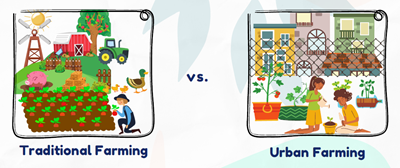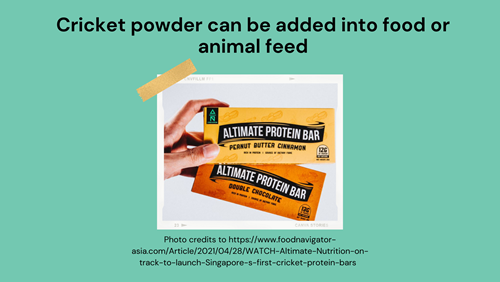On the Farm, At the Market
Author: G. Brian Karas
Publisher: New York: Henry Holt and Company, 2016
Discover Sustainability: Caring for the Environment
discovereads

For more resources for preschoolers on sustainability, click here!
Urban Farming - Farm to Table
Suitable for 4 to 6 years old

"All big things come from small beginnings." - James Clear
LET'S LEARN!
What is urban farming?
Urban Farming is growing or producing food in a city or heavily populated town. Look at the difference between traditional farming and urban farming below.

Why is learning about Farm to Table important for your child?
This concept is a way to teach your child where food comes from, which in turn will show that it's important to eat healthy and not waste what we have.
LET'S WATCH!
Your Food, Farm to Table
Summary:
Have you ever wondered how your food came to be produced the way it is today? From the field to your
table, a lot has changed - and improved - since farming first began, for both farmers and consumers.
LET'S PLAY!
Instructions
The next time you and your child go shopping for groceries, bring this fun scavenger hunt list along and identify what can be found at the supermarket or wet market. Let your child explore the fresh food you find at the markets before it makes it to their plate. Help them identify and name what their chosen food is too.
Find the scavenger hunt list in this link: https://go.gov.sg/supermarketscavhunt
Urban Farm at Home
Watch your seedlings grow, just like you!
Start your own home garden. By growing your own food, it’s a fun way for your child to learn about being self-sustainable.
Materials:
-
Watering can or bottle
-
Seed package
-
Old newspaper or cloth
-
Gardening tools
-
Planter or sturdy plastic boxes with holes and a tray
-
New soil or compost
Instructions:
-
Cover your table with the newspaper or cloth
-
Fill the planter or box with soil or compost
-
Use a trowel or use your fingers to scrape gently through the soil for airflow
-
Place the seeds into the holes in the soil and cover them back up
-
Find a place with plenty of sun and sprinkle some water
What's Growing On?
Explain to your child that it takes love, time and effort to grow something from a small seed. The biggest trees or the most beautiful flowers have grown from small seeds. And at the end of it, they’ll have their own homegrown herb. It’s something to be proud of.
LET'S READ!
All book covers are copyright of the respective publishing companies.
Sustainability at Home
Suitable for 4 to 6 years old

Being sustainable can start from small actions at home. No one is too young to become a sustainability warrior!
LET'S LEARN!
What is sustainability?

Sustainability refers to actions we can take today that will not reduce natural resources that others can enjoy in the future.
Singapore as a country is doing its part!

LET'S WATCH!
Singapore Green Plan 2030 | City of Green Possibilities
Summary:
What kind of brighter, greener future do we wish to build for Singapore? What will our City of Green
Possibilities bring, and how will we bring it to life?
LET'S THINK!
What can we do as inviduals and families?
-
Is it affordable?
-
Can we do this regularly and for a long time?
-
Does this method work for me or is it better for someone else?
LET'S TALK!
Discuss these questions with your family members.
-
Name 3 ways you can save water in the bathroom.
-
Name 3 ways you can reduce having too many items at home.
-
Name 3 ways you can reduce food waste.
-
Name 3 ways you can save energy at home.
-
What can you reuse or recycle at home?
LET'S READ!
All book covers are copyright of the respective publishing companies.
Urban Farming
Suitable for 4 to 6 years old

When you think of a farm, you might be picturing a big field with lots of fruits or vegetables being grown.
But did you know there are also farms in our city, including one on Orchard Road? Learn more about
these
urban farms and why they could be Singapore’s answer to securing a stable food supply for us all.
LET'S LEARN!

Urban Farming and Community Gardening are not the same!

What are the Different Types of Urban Farming?


LET'S WATCH!
Urban Farm in Singapore's Busiest Shopping District
Summary:
Watch this video to see a rooftop farm in Orchard Road!
LET'S THINK!
Talking Points
-
What does an Urban Farmer do on a day-to-day basis?
-
What are some of the produce you can grow in an Urban Farm?
-
What is the percentage of food in Singapore that comes from local produce?

LET'S LEARN!
Vertical Farming

What do you think is needed to start a Vertical Farm?

Answers:
- Structure
- Lighting
- Water
LET'S THINK!
Benefits of Vertical Farming

-
In a dense city with little land, Vertical Farming makes use of the space that is available.
-
70% to 95% less water is required for Vertical Farming compared to normal farming.
-
Unfavourable weather does not affect Vertical Farming. This way, more produce can be harvested.
-
No pesticides required! This makes it safe for farmers, consumers as well as the environment.

Urban Farms produce a lot of leafy greens that suit our tastebuds!
Do you know the common
names
of these vegetables used in markets?
LET'S PLAY!
Strawberry-Mint Lemonade
One of the most common plants you can try growing at home is mint. You can use the leaves to make the cooling drink with your family!


Method:
-
For simple syrup
In a large saucepan, combine 3 cups Water, the sliced Strawberries and Sugar. -
Bring to a boil, stirring until Sugar dissolves.
-
Reduce heat. Simmer for 5 minutes. Remove from heat.
-
Add Chopped Mint. Cover and let steep for 30 minutes.
-
Using a fine-mesh strainer, strain syrup to remove mint and berries. Let cool.
-
In a pitcher, combine 3 cups Cold Water, the simple syrup, Lemon Zest and Lemon Juice.
-
Add Lemon Slices along with additional Strawberry Slices and Mint Leaves.
-
Chill up to 4 hours before serving.
LET'S READ!
Old Manhattan Has Some Farms
Author: Susan Lendroth & Kate Endle
(Illustrator)
Publisher: Watertown, MA : Charlesbridge, 2017.
All book covers are copyright of the respective publishing companies.
Sustainable Foods
Suitable for 4 to 6 years old

Do you know that the food we eat has an impact on the environment? Find out how science and technology can help us create a planet-friendly food system! From meat grown in labs to insects that are safe for consumption, these new innovations could be the future of our food.
LET'S LEARN!
What are proteins?


Proteins are commonly found in animal sources of food such as meat, eggs and fish.
To rely less on animals for food, substitutes for meat are being created. They are called alternative proteins , which are food that provide proteins that do not come from animals.
Why are Alternative Proteins More Sustainable?

Let’s Learn About Alternative Proteins
Plant-based meat

LET'S WATCH!
Heme - The Magic Ingredient in the Impossible™ Burger
Summary:
Find out about the science behind plant-based meat in the Impossible™ Burger!
LET'S THINK!
Talking Points
-
What is heme and where can you find it?
-
How is Impossible Meat patty made?
Hint: There are three steps
LET'S LEARN!
Cultured Meat
Cultured meat is grown in labs from an animal cell
How is meat grown in labs?
- Extract an animal's stem cell. The animal is not hurt in the process.
- Cells are grown in the bioreactor.
- Cells grow and form a meat.
- Meat is harvested.
Insects
Insects are rich in protein, require less resources to raise and emit fewer greenhouse gases compared to livestock.


LET'S TALK!
-
Given the chance, would you try any of these alternative proteins? Why or why not?
-
How else can we make sustainable food choices in our everyday lives?
LET'S PLAY!
Scavenger Hunt at the Grocery Store!
Introduce your child to these plant-based proteins during your grocery trip!


LET'S READ!
Science You Can Eat
Author: Stefan Gates
Publisher: London : Dorling Kindersley Limited,
2019.
All book covers are copyright of the respective publishing companies.













